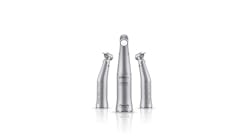I have it—you need it! iMatrix Clear, FluoroCal 5% Sodium Fluoride, and Stela Self-Cure Composite & Primer
iMatrix Clear System
For those of us committed to composite resin dentistry, tight contacts can sometimes be a challenge. Potentially there is the problem of inadequate photocuring of the resin restorative material around the marginal interface with the tooth. Often, I have used two curing lights—one buccal and one lingual—to ensure uniformity. The iMatrix Clear system has clear rings, clear sectional bands, and clear wedges to allow light to pass through and fully cure the resin. The NiTi rings offer increased visibility and can be stacked to facilitate MOD and multiple restorations. The tines have a unique “M” design that allows for easy wedge placement by providing good separation, and the clear sectionals will not fold or distort on placement and allow for ideal contact and marginal ridge form. Light can easily penetrate the clear wedges that are designed to allow for proper adherence to the tooth form. The system is as easy to use as any ring system, so the learning curve is minimal. It is packaged in a compact kit that can be placed on a tray set-up or placed neatly in a drawer when not in use. iMatrix Clear is valuable to dentists who want to provide long-lasting adhesive resin restorations.
FluoroCal 5% Sodium Fluoride Varnish with TCP
Hypersensitivity continues to be a problem that dentists and hygienists face almost daily. And, although I have written about FluoroCal before, this valuable product has now added two new flavors: bubblegum and green apple. Dentinal hypersensitivity is caused by exposed dentinal tubules. Accordingly, a common treatment is the application of 5% sodium fluoride varnishes, which aim to occlude and seal those tubules and stimulate fluorapatite creation. Overall, they generally do help to varying degrees. Bisco has introduced a fluoride varnish called FluoroCal, which combines fluoride and tricalcium phosphate (TCP) in a sustained release (over 24 hours) formulation. Research shows that the fluoride and TCP release is greater than leading competitors. This combination affords the patient protection from sensitivity along with acid resistance and strengthening of the enamel. Almost immediately, the patient will experience relief as the material penetrates and seals the exposed dentin tubules. Now there is a variety of pleasant-tasting flavors: spearmint, bubblegum, and green apple (all sweetened with xylitol) that are fast and easy to brush on. Another feature of this varnish is that although it is white in color, it blends esthetically with the patient’s dentition. Lastly, FluoroCal is made without gluten, dairy, or dairy proteins, making it suitable for patients who have allergies. FluoroCal is a product that will help us treat patients who suffer with dentinal hypersensitivity easily and effectively.
Stela Self-Cure Composite & Primer
I have practiced long enough to remember using alloy as a primary restorative material. It was durable and easy to use, required no shade matching, no adhesive resin, no layering, and no photocuring. Today, Stela offers us those same benefits in a composite resin available in capsule and flowable syringe formats. SDI boldly heralds it as an “amalgam alternative,” which may be alluring to those who have not yet made the transition to adhesive resin dentistry. Stela is used without mechanical retention, no photocuring, in one universal shade, and cures to any depth. And, while alloy achieved about 37% strength after an hour, Stela reaches 90% in the same time period. Both company and independent research shows it to have greater compressive strength than other leading bulk-fill composite restoratives. Bond strengths are further enhanced when used in combination with Stela Primer (total application time is only 15 seconds and requires no etching, scrubbing, or photocuring), designed to be compatible with Stela as they both contain MDP monomer that protects against sensitivity and provides for a more durable restoration. Stela Primer penetrates into the dentin for a mechanical bond, while Stela composite chemically bonds to the primer for a stronger chemical bond with only two steps. Stela’s unique, patented chemistry initiates curing toward the tooth structure, thus creating a gap-free interface resulting in one homogeneously cured restoration from dentin to the finished surface. Stela has high compressive strength, low-shrinkage with high flexural strength, good radiopacity, low wear, and polishes well. It also contains fluoride, calcium, and strontium. Overall, I think that Stela Self-Cure Composite and Primer are stellar!
About the Author

Howard S. Glazer, DDS, FAGD
Howard S. Glazer, DDS, FAGD, is a fellow of the Academy of General Dentistry, American College of Dentists, International College of Dentists, American Society for Dental Aesthetics, American Academy of Forensic Sciences, and a diplomate of the American Board of Aesthetic Dentistry. He is an attending dentist at the Englewood Hospital in Englewood, New Jersey, and the deputy chief forensic dental consultant to the Office of Chief Medical Examiner, City of New York.


